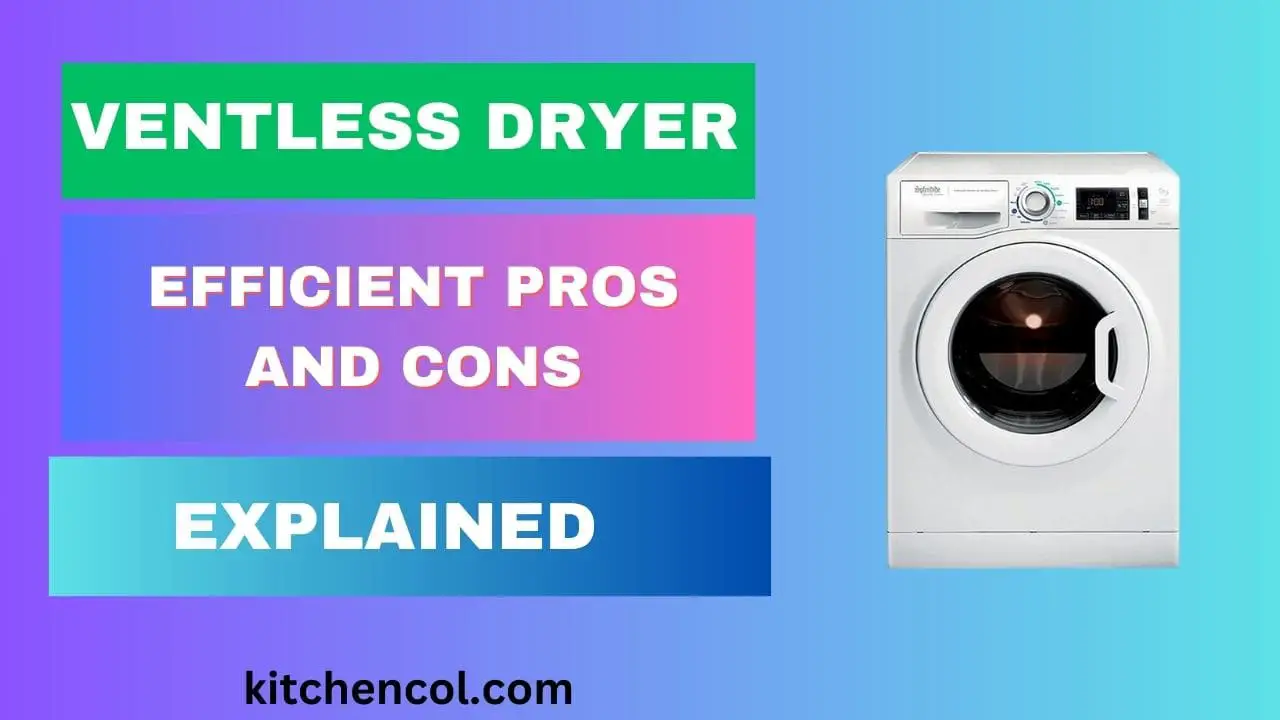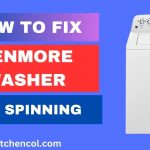Traditional dryers have long been a staple in households, yet ventless dryer is emerging as a compelling alternative. Unlike their vented counterparts, these innovative appliances offer unique benefits and present distinct challenges. In this article, we delve into the world of ventless dryers, exploring their pros and cons to help you determine if they’re the right fit for your laundry needs.
Understanding Ventless Dryers
In the world of laundry appliances, ventless dryers stand out as an innovative alternative to the conventional vented models. Unlike traditional dryers that expel hot, moist air through an external vent, ventless dryers operate differently, offering distinct advantages and mechanisms.
A. Definition and Varieties
Ventless dryers, as the name suggests, operate without the need for external venting. This fundamental difference sets them apart from traditional dryers. There are primarily two types of ventless dryers: condenser dryers and heat pump dryers.

- Condenser Dryers: These units utilize a heat exchanger to cool down and condense the moisture extracted from the clothes. The condensed water is then collected in a reservoir or drained away, while the remaining dry air is reheated and circulated back into the drum.
- Heat Pump Dryers: This type of ventless dryer uses a heat pump to generate hot air, which then evaporates moisture from the clothes. The evaporated moisture is condensed, and the heat generated during this process is recycled to aid in drying, making them more energy-efficient than condenser dryers.
B. Mechanisms at Work
- Operational Overview: Ventless dryers function by recirculating air through the drying process, without the need for venting the hot air outside. They use innovative technologies to dry clothes efficiently within an enclosed system.
- Environmental Impact: Compared to traditional vented dryers, ventless models have a more eco-friendly footprint. They often consume less energy and minimize heat loss, contributing to reduced environmental impact.
C. Efficiency and Adaptability
- Space Flexibility: One of the significant advantages of ventless dryers is their adaptability to various living spaces. They don’t require a vent to expel hot air, making them suitable for apartments, condos, and other compact living areas where vented dryers might be impractical.
- Energy Efficiency: Ventless dryers typically use less energy than vented models, potentially leading to lower utility bills over time. Their innovative design allows for efficient drying while minimizing energy waste.
D. Moisture Management
- Moisture Capture: In condenser dryers, the process of capturing and reusing moisture allows for efficient drying while reducing water wastage. This feature makes them advantageous in areas where water conservation is a concern.
- Suitability for Different Climates: Ventless dryers, particularly condenser types, can be beneficial in humid climates since they capture and manage moisture effectively, ensuring efficient drying regardless of external conditions.
Understanding the mechanisms and advantages of ventless dryers provides insight into their unique functionality and suitability for different living environments. These features make them a compelling option for those seeking efficient and adaptable laundry solutions without traditional venting requirements.
Pros of Ventless Dryers
Ventless dryers offer several advantages that make them an attractive option for many households, especially in situations where traditional vented dryers might not be practical. Here are the key benefits:
A. No Need for External Venting
- Ideal for Limited Spaces: Ventless dryers don’t require an external vent, making them perfect for apartments, condos, or homes where installing a venting system is challenging or impossible.
- Greater Installation Flexibility: The absence of venting needs allows for more versatile installation options, such as under countertops or in closets, maximizing available space.
B. Energy Efficiency
- Reduced Energy Consumption: Ventless dryers typically use less energy compared to vented models. Their closed-loop system recirculates air, reducing heat loss and energy wastage, leading to potential long-term cost savings on utility bills.
- Heat Recovery: Heat pump dryers, in particular, use innovative heat recovery systems that recycle heat, enhancing energy efficiency by utilizing the generated warmth to aid in the drying process.
C. Moisture Capture and Reuse
- Condenser Technology: Condenser dryers capture moisture from the clothes and then reuse it or drain it away. This feature not only aids in drying but also conserves water, making them environmentally friendly.
- Suitable for Humid Climates: Ventless dryers, especially condenser types, are effective in humid environments as they efficiently manage moisture without being dependent on external air conditions.
D. Quieter Operation
- Reduced Noise: Ventless dryers are generally quieter during operation compared to traditional vented models. Their enclosed design and advanced technology contribute to a more peaceful laundry experience.
E. Reduced Risk of Air Contaminants
- No Venting of Contaminants: Since ventless dryers don’t expel air outside, there’s a reduced risk of contaminants or allergens being circulated into the environment, ensuring a cleaner indoor air quality.
Ventless dryers’ unique features not only offer convenience and efficiency but also cater to specific environmental and space-related needs. These advantages make them a compelling choice for those seeking versatile and energy-efficient laundry solutions in various living scenarios.
Cons of Ventless Dryers
While ventless dryers offer several advantages, they also come with some drawbacks that potential users should consider before making a purchase. Here are the key cons associated with ventless dryers:
A. Longer Drying Times
- Extended Drying Periods: Ventless dryers generally take longer to dry clothes compared to traditional vented dryers. The closed-loop system and lower operating temperatures contribute to the extended drying times.
B. Initial Cost and Maintenance
- Higher Upfront Cost: Ventless dryers often come with a higher initial purchase price compared to vented models. The advanced technology and innovative features contribute to the increased upfront investment.
- Maintenance Needs: These dryers require regular maintenance, including cleaning filters, condenser units, and moisture collection systems. Neglecting maintenance can lead to reduced efficiency and performance.
C. Potential for Increased Heat in the Room
- Heat Emission: Heat pump dryers, in particular, may release warm air into the room during operation, potentially raising the ambient temperature. This factor might be uncomfortable in already warm climates or during hotter seasons.
D. Complex Installation Requirements
- Specific Installation Guidelines: Ventless dryers may have specific installation requirements due to their unique design. Improper installation could affect performance and efficiency.
E. Compatibility with Fabric Types
- Delicate Fabric Handling: Some ventless dryers might not be as gentle on delicate fabrics due to the lower operating temperatures, potentially requiring longer drying times for certain materials.
F. Adaptation to Longer Drying Cycles
- Adjustment Period: Users transitioning from vented to ventless dryers might need time to adapt to the longer drying cycles, which could be an inconvenience for those accustomed to faster drying times.
G. Limited Load Size and Capacity
- Reduced Load Capacity: Ventless dryers might have smaller load capacities compared to traditional vented dryers, limiting the amount of laundry that can be dried in a single cycle.
Understanding these drawbacks associated with ventless dryers is essential for potential buyers to make an informed decision. While they offer unique benefits, these cons highlight certain limitations and considerations that individuals should weigh based on their specific needs and preferences.
Comparison with Vented Dryers
When deciding between ventless and vented dryers, it’s crucial to weigh the advantages and disadvantages of each type to determine the most suitable option for your household. Here’s a comprehensive comparison:
A. Efficiency and Performance
- Drying Time: Vented dryers typically have shorter drying cycles compared to ventless models due to their higher operating temperatures and the ability to expel hot, moist air outside efficiently.
- Energy Consumption: Ventless dryers are generally more energy-efficient, consuming less power during operation by recycling air within a closed loop. Vented dryers, however, expel hot air and might contribute to heat loss in the house.
B. Cost Differences
- Initial Purchase Price: Vented dryers usually have a lower upfront cost compared to ventless models, making them a more budget-friendly option initially.
- Operating Costs: Over time, ventless dryers might lead to lower utility bills due to their reduced energy consumption. However, this can vary based on usage patterns and energy prices.
C. Space and Installation Requirements
- Venting Needs: Vented dryers require an external vent to expel hot air, limiting installation options and making them less suitable for apartments or spaces without venting capabilities.
- Installation Flexibility: Ventless dryers offer more flexibility in placement due to their lack of external venting requirements, allowing for installation in smaller or unconventional spaces.
D. Maintenance and Longevity
- Maintenance Complexity: Ventless dryers might require more frequent maintenance due to their design, including cleaning filters, condenser units, and moisture collection systems. Vented dryers have simpler maintenance requirements.
- Long-Term Durability: Both types of dryers can have a similar lifespan if properly maintained, but the complexity of ventless dryer systems might affect long-term reliability.
E. Environmental Impact
- Energy Efficiency: Ventless dryers, being more energy-efficient, have a lower environmental impact compared to vented models due to reduced energy consumption.
- Moisture Management: Ventless dryers, especially condenser types, effectively manage and reuse moisture, contributing to water conservation efforts.
Understanding these comparative aspects between ventless and vented dryers is vital in choosing the right appliance that aligns with your specific requirements, living space, and preferences. Each type has its distinct advantages and limitations, and evaluating these factors can guide users in making an informed decision.
Tips for Using Ventless Dryers
To optimize the performance and efficiency of ventless dryers, here are some practical tips and guidelines to consider:
A. Proper Maintenance and Cleaning
- Regular Filter Cleaning: Clean the lint filters before or after each cycle to maintain proper airflow and prevent lint buildup, ensuring efficient drying.
- Condenser and Moisture Collection Maintenance: Follow manufacturer guidelines to clean the condenser and empty or drain the moisture collection system as recommended to maintain optimal performance.
B. Load Size Recommendations
- Avoid Overloading: While it’s tempting to maximize each load, avoid overloading the dryer as it can hinder proper airflow, resulting in longer drying times and less effective drying.
- Optimal Load Size: Aim for medium-sized loads to ensure proper tumbling and airflow within the drum for efficient drying without overtaxing the machine.
C. Adjusting to Longer Drying Times
- Plan Ahead: Since ventless dryers often take longer to dry clothes compared to vented models, plan laundry cycles accordingly to account for extended drying periods.
- Patience and Adaptation: Allow for an adjustment period if transitioning from a vented dryer to a ventless one. Be patient and adjust expectations for drying times accordingly.
D. Use Appropriate Settings
- Utilize Sensor Technology: Many ventless dryers come with sensor-based drying cycles. Use these settings to allow the dryer to automatically adjust the drying time based on moisture levels in the clothes.
- Adjust Settings for Fabric Type: Opt for specific settings designed for different fabric types to ensure gentle and efficient drying, especially for delicate or sensitive materials.
E. Ensure Proper Ventilation
- Room Ventilation: Since ventless dryers release warm air into the room, ensure proper ventilation to prevent excessive heat buildup, especially in smaller spaces.
- Maintain Air Circulation: Keep the area around the dryer clear to facilitate adequate air circulation for efficient operation and to prevent overheating.
F. Read Manufacturer Instructions
- Follow Manufacturer Guidelines: Always refer to the user manual for specific instructions and maintenance schedules provided by the manufacturer for your ventless dryer model.
- Professional Servicing: Consider professional servicing or inspections periodically to ensure the dryer’s components are functioning optimally.
By following these tips, users can maximize the efficiency, performance, and longevity of their ventless dryers while adapting to their unique drying characteristics and maintaining proper care for the appliance.
Also Read: How to Fix Whirlpool Washing Machine Stuck on Wash Cycle
Final Words
Ventless dryers offer a versatile and energy-efficient solution for various living spaces, especially where traditional vented models pose installation challenges.
Despite longer drying times and initial costs, their flexibility reduced environmental impact, and suitability for smaller spaces make them a compelling choice.
By understanding their advantages, and maintenance needs, and adjusting expectations, users can harness the benefits of ventless dryers, providing efficient laundry solutions while contributing to energy conservation efforts.
Ultimately, weighing the pros and cons helps individuals make informed decisions based on their specific needs and living circumstances.

My name is Manan Bukhari and I am an expert in reviewing kitchen products for years. I have a passion for testing multiple gadgets especially related to home & kitchen. I love to spend my free time in resolving issues if I face some in any of my daily use things. I have fixed multiple gadgets of my home on my own without any assistance and that thing gave me confidence to make a blog on troubleshooting of items that are for daily use to assist you folks. Even my wife praises me for having such talent. I always explore new machines on my own because this thing fascinates me.



